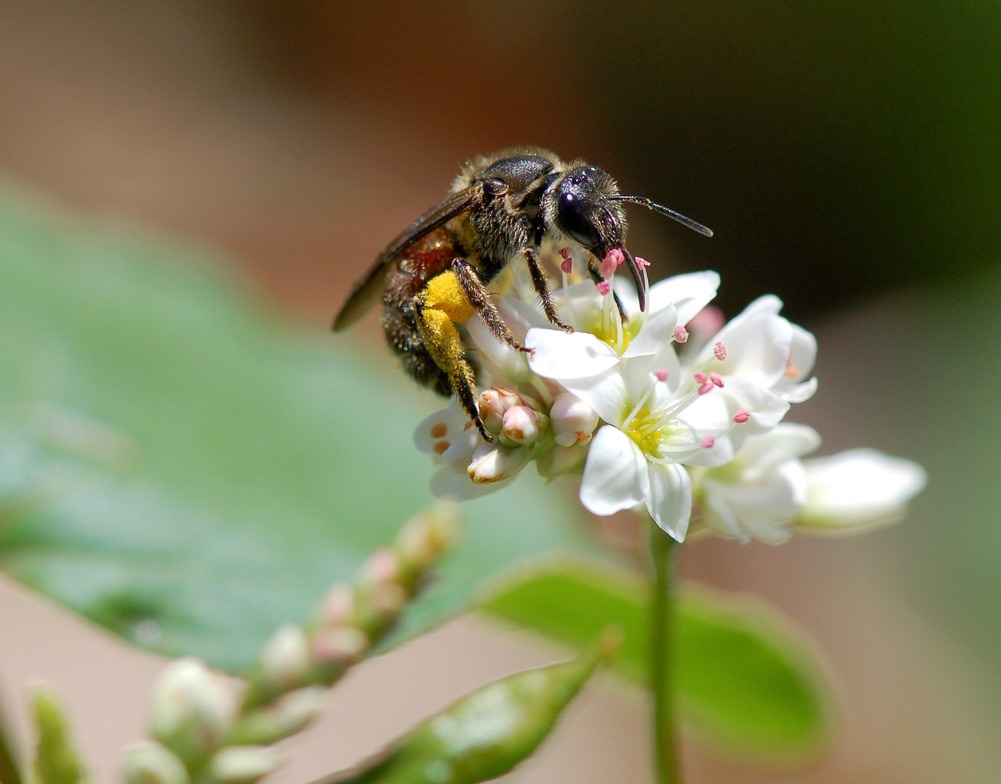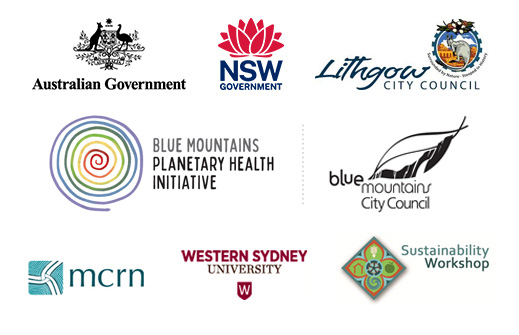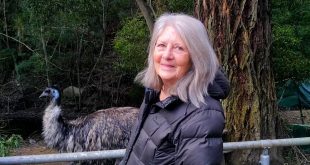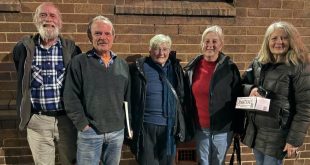
Lasioglossum (Parasphecodes) (Supplied by Megan Halcroft)
Story by Tracie McMahon
Dr Megan Halcroft, from Hampton, is a leading educator on native bees. She’s creating awareness around the critical role of our native bees in protecting biodiversity. She spoke with Lithgow writer Tracie McMahon at Eskbank House earlier this year.
Key Points:
- Native bees co-evolved over 125 million years with our native flora and if we don’t look after them, we will lose not only the plants they pollinate, but all flora and fauna dependent on the plants they pollinate.
- Australian Pollinator Week runs from 11-19 November in 2023.
Share this article:
Dr Megan Halcroft is passionate about native bees. “Native bees are awesome,” she enthused to the audience at a sold-out presentation at Eskbank House Museum in June.
Megan runs Bees Business, providing educational resources, workshops and presentations on native pollinators throughout Australia. She also co-moderates the public Facebook group Bee Aware of Your Native Bees (Australia). The group has over 35,000 members and averages around 50 posts each week. Members ask questions, and discuss and share ideas and images all aimed at increasing awareness and understanding of Australia’s native pollinators.
Lithgow writer Tracie McMahon spoke with Megan about native bees and her role as an educator and speaker.
How did you get involved with native bee education?
I completed my PhD in 2013 at Western Sydney University on a stingless bee, Austroplebeia australis, and just ‘fell in love’ with native bees. When I was finalising my PhD, I was introduced to Jen Dollin from the Office of Sustainability at the University who asked: ‘If we can get funding for you to continue your work on native bees, what would you do?’
My answer was simple: create awareness. Native bees drive biodiversity. They have co-evolved over 125 million years with our native flora and if we don’t look after them, we will lose not only the plants they pollinate, but all flora and fauna dependent on the plants they pollinate. Yet, most people do not even know we have native bees in Australia.
I was asked to submit a proposal and the University was successful in receiving funding from the NSW Department of Environment and Heritage for the ‘Bee Aware of Your Native Bees’ project. It was based around five Western Sydney community gardens located in Parramatta, Penrith, Katoomba, Richmond and Lithgow. Eskbank House Museum was the host for Lithgow’s community events, which involved the installation of a bee hotel, and increasing participants’ understanding of the flora and habitat available on the site. During one of the workshops, we found an aggregation of hundreds of bees nesting in the ground, which no one was aware of.
The grant funded a series of seminars, workshops, the creation of a social media platform for each community and culminated in a symposium on native bee identification and habitat.

Example ‘bee hotels’ shown at the Eskbank House Museum presentation
The native bee symposium attracted several high-profile speakers such as Michael Batley and Martyn Robinson from the Australian Museum, Tanya Latty from The University of Sydney, Jenny Shanks from Western Sydney University, and Anne and Les Dollin from the Aussie Bee, and over 200 attendees.
How did you keep the momentum going after that initial funding?
As the grant came to its end, Western Sydney University advised me that there was a small amount of funding remaining and asked what I wanted to do with the money.
At the time, a fellow bee researcher and PhD candidate, Jenny Shanks, and I were trying to inspire people to be part of ‘Pollinator Week’, being celebrated during June/July in the Northern Hemisphere. I can tell you, mid-winter is a very uninspiring time of year to promote bees, so I decided this is how I wanted to spend the excess funding: on Australian Pollinator Week, in our Southern Hemisphere spring. This would be a great way to create awareness about pollination and insect pollinators in Australia. The funding was used to develop a proposal for an ‘awareness’ week in Australia’s spring when the bees were most active and noticeable. It so happened that the Australian ‘wild pollinator count’, which was established the previous year by independent researchers, was conducted in November each year. So Australian Pollinator Week was launched to coincide with the November count, to help increase collaboration and a broader community awareness. We received funding and continued from there. I am still creating resources and speaking on native bees and enjoying it.

Megan demonstrating how to construct a simple bee hotel from Hydrangea prunings at the Eskbank House Museum presentation.
How did the Australian Pollinator Week project go?
In 2015, we organised and held 23 events right across Australia. The Facebook group Bee Aware of Your Native Bees, which had been created as part of the initial Bee Aware project, was used to promote events which were organised by local community groups. The week was small but successful. In 2017, the Royal Botanic Gardens in Sydney offered their support, and the range and number of events grew. In 2018, I handed custodianship of Australian Pollinator Week to the Wheen Bee Foundation, a not-for-profit bee charity. With their support, it has grown to include events and webinars across the country for all ages, such as pollinator picnics, a research-grade pollinator count, and dance, song and photographic competitions to educate people and celebrate pollinators. The Bee Aware of Your Native Bees Facebook group has also grown with it and now has over 33,000 members.
What have been your successes?
I feel like I’ve made a difference when I see comments on the Facebook group like: ‘Before I came here, I used to spray everything, now I don’t.’ People are becoming more aware of native bees and other beneficial insects and the impact of their actions.
Many people just want to know how they can help, or just learn more, particularly on how to distinguish a native bee from other insects. Most of the members of the Facebook group are there to read, watch and learn. The most common questions are around identification, constructing bee hotels and habitat for bees. I consider I’ve done my job if people know more about native bees or just want to know more.
I have been fortunate to have gained support at critical points. I met Fiona Chambers, the CEO of the Wheen Bee Foundation, at a conference in 2017. She invited and sponsored me to attend their upcoming ambassador program, which I accepted. I was very nervous about being the only native bee specialist amongst a group of honeybee keepers. Especially when I would be discussing the adverse impacts of honeybees on native pollinators. To my surprise these discussions went well, and I asked if I could do a follow up with a presentation on Australian Pollinators Week.
That presentation led to Wheen Bee Foundation taking custodianship of Australian Pollinators Week and me becoming the Australian Native Bee ambassador for them. Without their marketing, communications and audience we would have reached far fewer people.
If there was something people could do right now to help the native bee population, what would it be?
I get asked this question all the time and my answer is always the same: plant, plant, plant. Make sure it has diversity and abundance, so there will be flowers from late winter to late autumn. And don’t be too tidy. Pollinators need food, and habitat. It can be a mix of natives and introduced species. Many native bees are comfortable with introduced species, while others are dependent on a particular native species. There are over 2000 species of bees in Australia. Some will live for as little as a month and they have co-evolved over the last 125 million years to work in tandem with flowering plants.


Megan’s home garden incorporates bare earth with a mix of introduced and native flowering ground covers and shrubs, and fruiting trees.
Take Action:
- To learn more about Australian Pollinator Week or get involved in some of their activities, visit their website which contains details of events across the country.
- For more information on designing native bee friendly environments, The Wheen Bee Foundation and Bees Business websites have downloadable resources as well as links to other experts in the field.
Share this article:
This story has been produced as part of a Bioregional Collaboration for Planetary Health and is supported by the Disaster Risk Reduction Fund (DRRF). The DRRF is jointly funded by the Australian and New South Wales governments.





One comment
Pingback: Birds, Bees, Butterflies & Bats Pollinator Project | Blackheath Area Local News